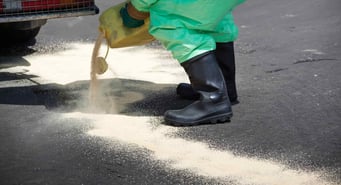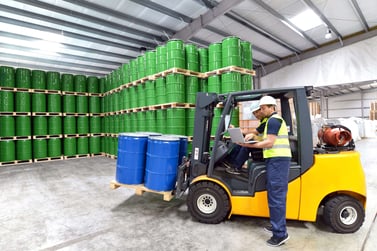Does your workplace carry any type of hazardous chemicals? If you’re one of the thousands of Australian businesses that handle these substances, keep in mind that your organisation has a legal obligation to contain any chemical spills and leaks. In today’s blog, we’ll look at the importance of minimising risks associated with hazardous chemical spillage through compliant bunding and secondary containment equipment.
Why Is Bunding and Secondary Containment Important?
Secondary containment is a hazard minimisation strategy that is used to address the issue of chemical spills and leaks in the workplace. A key element of your secondary containment plan is bunding and bunded storage.
Spill bunding is designed to contain chemical spills and leaks — and stop them from spreading through the workplace or into the surrounding environment. For example, if your business has flammable or combustible substances which aren’t contained in a compliant manner, a chemical leak could result in further workplace hazards such as fire and explosion.
As stated in Work Health Safety (WHS) Regulations, all Australian workplaces have a legal obligation to contain and manage spills. The Model WHS Regulations explains:
Section 357 Containing and managing spills
“Where there is a risk from a spill or leak of a hazardous chemical, provision must be made for a spill containment system that contains any part of the hazardous chemical that spills or leaks — and any resulting effluent.”

Your organisation has a legal obligation to contain, manage and clean up chemical spills
But how do you develop an effective secondary containment plan for your flammable liquids? Read our quick guide to find out more about the next steps that you need to take:
Step 1. Determine The Level Of Risk
Before making purchasing decisions about bunding and other secondary containment products for your hazardous substances, it’s extremely important to determine the level of risk created by the chemicals.
To make sure you choose the correct bunding and secondary containment equipment for your worksite, we highly recommend a risk assessment. The risk assessment will allow you to identify the physical properties of the substance — and find out if the equipment can cope with the handling quantities, climate and duration of the load.
You should consider the following risk factors at your worksite:
- Health hazards — what health risks would a chemical spill pose to workers? This includes chemicals burns to the skin and eyes, as well as what would happen if the spilled chemicals were ingested, inhaled or swallowed.
- Physical hazards — what is the flashpoint of the chemicals, and how likely are they to ignite or explode during an uncontrolled leak or spill?
- Environmental hazards — are the chemicals toxic to the environment? What is the minimum quantity required to contaminate groundwater or pastoral lands? Is the job site located near the ocean, waterways, drains, forestry, or residential areas?
- Chemical properties — are the chemicals corrosive or reactive? Could the chemicals attack or quickly corrode bunding construction materials?
- Chemical quantities — what quantities are you carrying and what are the concentration levels? Your level of risk is much different for a jerrycan of mower fuel vs a bulk tank of unleaded petrol.
- Temporary storage — if there are temporary storage areas for flammable liquids, how long will they be kept there?
- Site vulnerability — is the job site vulnerable to storms, flooding, heat, traffic or offsite risks on adjacent properties? Does the workplace carry explosives or other Dangerous Goods?
- Containers — what type of chemical containers are being used and how vulnerable are they to cracking, impact, deterioration, overfilling or collapse?
Step 2. Assess Chemical Handling and Storage Areas
The Environmental Protection Authority (EPA) recommend that the requirement for bunding and secondary containment should be determined on a site-by-site basis.
Our Dangerous Goods Specialists recommend factoring the following workplace areas into your risk assessment:
- Indoor safety cabinets
- Outdoor flammable liquid stores
- Drum storage areas
- Chemical decanting stations
- Pesticide storage
- Bulk tanks and other fuel storage areas
- Electrical transformers and other machines that contain oil
- Equipment used to transfer stored liquids (eg, drum trolleys)
- Locations where chemical spills commonly occur (eg, maintenance workshops, laboratories, production areas, wash bays, loading docks, warehouses, engine rooms)
 You can determine your need for bunding and secondary containment by conducting a detailed risk assessment
You can determine your need for bunding and secondary containment by conducting a detailed risk assessment
IMPORTANT: When calculating the capacity for flammable liquids bunding you should also consider the impact of water and liquids produced by firefighting equipment.
Step 3. Consider Bunding Solutions
Now that you’ve determined the level of risk and assessed your chemical handling and storage areas, it’s time to consider the bunding options available.
While each workplace will require a tailored solution when it comes to bunding, we’ve highlighted some of the most popular Australian-made bunding products.
Bunding solutions for your business may include:
IBC Bunds
Are you using intermediate bulk containers (IBCs) at your organisation? The following Australian-made bunding products are available for standard IBCs:
- IBC bund — this bund sits under a single IBC allowing it to be used as a decanting station. It has the capability to hold the entire contents of the IBC
- Spill funnel — the funnel attaches to the opening of the IBC to allow spill-free decanting into the IBC. The spill funnel also has a debris strainer
- Dispensing tray – this handy device attaches snugly to the IBC bund, sitting under the tap, to catch any overfill or splashing while decanting
Drum Handling
When you need to minimise spillage during decanting, handling and location transfer, drum handling bunding is a great option. These bunding products can be attached to individual chemical and fuel drums.
Drum handling and dispensing products include:
- Drum dolly — this dolly allows staff to move chemical drums around the worksite. The swivel-wheeled drum dolly base also acts as a spill bund
- Drum caddy — you can secure the drum to the wheeled caddy with in-built ratchet straps. The drum can then be manoeuvred to any angle for decanting or injury-free transfer
- Spill funnel lid — the funnel is placed over a chemical drum to prevent overfilling and spillage while decanting. The lid also has a debris strainer
- Full cover lid — this close-fitting lid covers the full circumference of a 205 L drum
IMPORTANT: Bunding products can also be fitted to single pallets or as part of a bunded racking system.
Step 4. Minimise The Risk Of Spills
If you want to support your bunding and secondary containment systems, and minimise the risk of chemical leaks and spills, we recommend you do the following on a regular basis:
- Check chemical containers for cracks and other damage that can start to leak
- Regularly inspect machinery — especially pumps, valves, pipes and hoses
- Clear the spill sump in chemical cabinets and outdoor stores immediately after a spill
- Keep only minimum quantities of hazardous substances onsite
- Implement consistent housekeeping practices to reduce clutter, and ensure all chemical containers have the lids in place
What’s Your Secondary Containment Solution?
Developing and maintaining a secondary containment system for your hazardous substances will help your business minimise the serious risks associated with chemical spills.
If your organisation is carrying Class 3 Flammable Liquids, such as petrol, lubricating oil, paint or acetone, you face the increased risk of hazard due to the potential for fires and explosion. So, it’s good to know that you can solve your chemical storage and containment issues with compliant, Australian-made flammable cabinets. Our team at STOREMASTA manufacture flammable liquids cabinets and bunded storage options that meet the requirements of AS 1940:2017 – The storage and handling of flammable and combustible liquids. Our innovative designs provide liquid tight secondary containment for flammable liquids — and will significantly reduce the risk of an uncontrolled chemical spill at your worksite.
If you’d like to learn more about bunding, secondary containment and flammable liquids compliance, we can help. Our FREE eBook, Essential Considerations When Storing Flammable Liquids Indoors, details our 4-STEP risk management methodology: IDENTIFY – ASSESS – CONTROL – SUSTAIN, which can be applied to your workplace or your specific flammable liquids hazards. Click on the image below to access our full guide today and learn more about compliant chemical storage and containment today.
Joining the team as a Dangerous Goods Storage Consultant, Melissa Hampton became Storemasta's Marketing Manager in late 2021. With extensive knowledge and experience in chemical compliance, Melissa is responsible for leading the Marketing team and helping shape their marketing strategy. In her spare time, you can find Melissa hiking, swimming and enjoying the great outdoors in beautiful north-west Tasmania.
